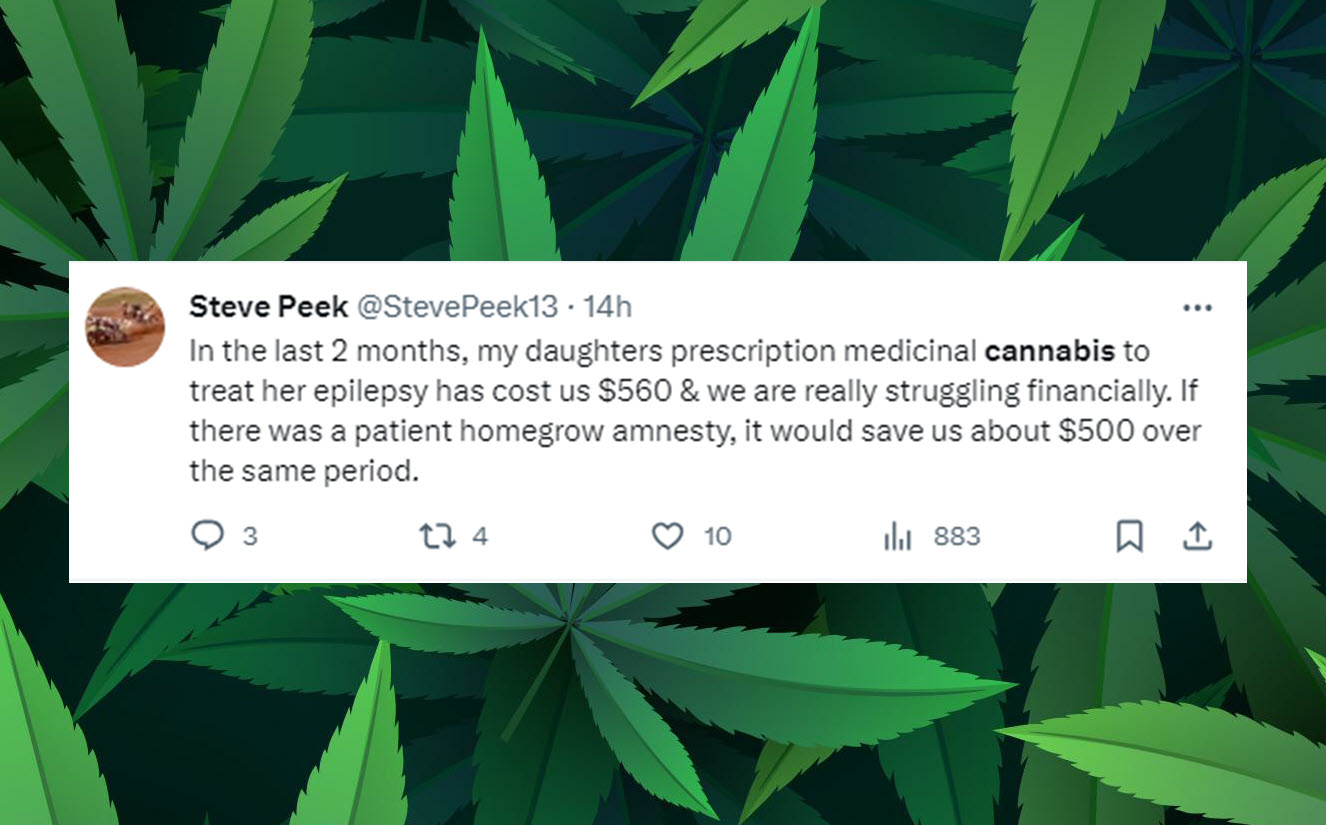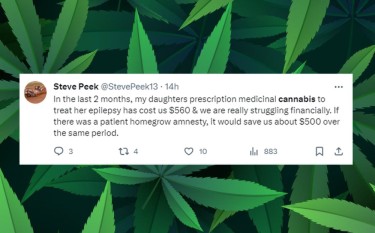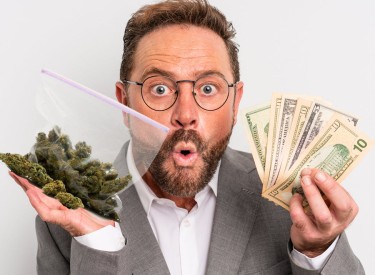Cannabis News
The Pain of Paying – Seeking Cannabis on a Budget Because You Have No Choice
Published
1 year agoon
By
admin
The Pain of Paying: Seeking Cannabis Relief on a Budget
What is a “nodal grow” by Reginald Reefer

My heart sank reading a recent tweet about the crushing cost of medical cannabis for one patient with epilepsy – $560 a month, breaking their budget. The sheer injustice and helplessness of lacking access to affordable medicine that could ease their suffering upset me deeply.
In an ideal world, no one should have to ration relief they need based on ability to pay. Yet pharmaceutical greed oppresses so many into needless pain, unable to afford monopolized pills and treatments.
The cannabis plant graciously offers medicine freely to the people, if only law allowed. No one should suffer due to corporate profit motives restricting nature’s cures.
So while I can’t directly remedy this reader’s situation, perhaps some ideas could help them and others struggling financially to independently cultivate their own affordable medicine.
The concept of a “nodal grow op” came to mind, distributed cannabis cultivation within a medical collective to maximize yield, lower costs, and ensure continuous supply.
Picture an umbrella network of trusted patients growing at staggered cycles. Each harvest gets shared among the group, so medicine remains abundant without reliance on dispensary price gouging.
Of course laws prohibit personal growing in many areas, forcing dependence on commercial licenses catering to the affluent. But where patients face economic barriers to relief, cultivating communally could provide ethical, sustainable access.
My aim today is to explore pragmatic DIY solutions for homegrowers that empower self-sufficiency and mutual aid. The plant wishes to spread healing freely to those in need, not be monopolized for profit.
While civil disobedience carries risks, humanity calls us to care for those suffering when rules fail justice. If regulations won’t allow affordable access, then we must reclaim our plant sovereignty. The simplest solutions often arise from compassion.
At first glance, growing your own medical cannabis may seem intimidating. But with basic horticultural skills and some trial-and-error wisdom, crafting professional quality medicine at home is within most anyone’s reach.
Cannabis itself is one of the more forgiving, resilient plants to cultivate. It thrives on little more than sunlight, water, and quality soil as any weed would – the nickname rings true. Just meeting the plant’s basic needs often yields usable medicine.
Dialing in perfect growing conditions and specialized techniques takes practice. But new hobbyists should find some early success just sprouting quality seeds in a sunny garden patch or indoor tent. Don’t overthink early efforts – the plant itself guides you in its needs.
By the second or third personal harvest, most home growers will have developed enough familiarity with their strains to make adjustments improving potency, yield, aroma, etc. This experiential education deepens intuition around optimizing the cannabis’ unique expression.
With time, tools like targeted nutrients, hydroponics, training methods, and environmental controls help refine quality and customize medicine for patients’ needs. But a serviceable first crop requires little beyond sun, soil, water, and seeds.
Patience and attentiveness while learning the plant’s signals and needs is key. Cannabis tells you how to nurture it best, if you listen closely. And as with any garden, each one teaches new lessons.
Of course, certain medical conditions may require dialing in specific cannabinoid levels through controlled growing methods. Here resources and community networks become invaluable for sharing wisdom. Most obstacles have been solved by fellow growers ready to advise.
And auto-flowering strains nowadays make quality cannabis accessible for even non-gardeners. They transition from seed to harvest within months with minimal inputs. Plant the seed and watch it grow.
While mastering flawless medical cannabis takes years of passion, providing for personal medicine goals can begin far more simply. With good genetics and intention, the plants themselves gracefully guide novices to bountiful remedies.
Fear not the first steps! It’s a journey that leads to self-sufficiency!
Once committed to creating a communal cannabis cultivation collective, or “nodal” grow op, the first challenge becomes finding the right members. This requires deep discernment and gradual relationship building to ensure shared ethics and security.
Rather than hurriedly piecing together strangers solely around a transactional arrangement, the aim is assembling a circle of true peers bound by mutual understanding, care and commitment to a cause larger than oneself. A tribe formed first and foremost on trust.
In an age of social alienation, people may instinctively dismiss the idea of trusting others with knowledge of illegal activity as naive, even reckless. But in reality, it reflects reawakening to the interdependence and goodwill binding us beyond fear-based isolation.
Begin by reaching out privately to connect with just a few local parents in similar situations, using discretion and intuition as guides. Get to know their character and struggles organically over time before broaching sensitive topics.
Watch for those who express natural care, wisdom and discretion alongside desperation born of injustice. As rapport solidifies into friendship, openness and care will arise in their own time, rooted in genuine human connection.
From the initial few, expand thoughtfully and slowly to others who resonate with the cause through trusted referrals. But avoid over-eagerness – any whiff of unhealthy motive or coercion ruins sacred trust before it can even form.
Rather than quantity, emphasize discernment and chemistry. Remain patient in unfolding the network organically to keep its foundation of affinity strong. Just a few harmonious souls can birth tremendous change.
Of course, legally this requires civil disobedience. But framing it as such inflames paranoia and separation. We are simply friends helping friends access the plant medicines we are biologically entitled to, though rules may oppose it.
Approached thusly, the urgency of suffering eclipses any hesitation around breaking flawed legislation. Outdated policies crumble before compassionate humanity.
At the heart, this is a process of returning to community interconnection. Forming a circle of trust who through communication can organize to serve its members equitably and fill urgent needs left unaddressed by callous systems.
Some may dismiss this concept as unrealistic idealism. But pragmatic, caring solutions emerge when we step past isolationist worldviews built on fear and mistrust. If claims of family and community hold substance, now is the time to demonstrate it through action.
The remaining piece is inner work in each of us to dissolve lingering selfishness and cynicism blocking trust. For in the end, the walls that divide us run through every mind and heart. And only through truly joining hands do we mend the world.
Once a trusted collective is formed, we can begin planning a coordinated cannabis cultivation schedule that continually provides medicine for all members. This requires calculating plant counts and staggering grow cycles to ensure ample yield.
For example, consider 4 epilepsy patients each needing about 3-4 ounces of RSO every 3 months. That comes out to around 12-16 ounces of RSO needed by the group per quarter.
Since 1-2 ounces of flower makes 4-8 ounces RSO when processed, each individual cannabis plant yields enough oil for 2-4 patients when finished.
With 4 patients needing that 12-16 ounces of RSO per quarter, the collective would need approximately 3-4 plants per member every harvest cycle to produce enough medicine for the group’s needs.
So a workable sequence would be:
Member A starts 3 plants on January 1st
Member B starts 3 plants on April 1st
Member C starts 3 plants on July 1st
Member D starts 3 plants on October 1st
Within one year following this seasonal staggered schedule, each member will have cultivated a total of 12 plants (3 plants x 4 harvests), which should produce the estimated 48 ounces of RSO needed annually by the group.
Of course, depending on actual yields and efficiencies in oil production, more or less medicine may be created per plant. So the collective agrees to monitor supply closely and adjust individual plant counts and processes as needed. The goal is optimizing quality and continuity of medicine.
By clearly communicating timing for starting grows and sharing resources cooperatively, the group can maintain a steady, sustainable supply of RSO for all patients. This thoughtful coordination and planning is key.
Further adjustments will occur over time to dial in preferred cannabis strains, maximize yields, and synchronize harvests. But starting with the math provides an invaluable template to build upon together through real-world experience.
Beyond medicine, preserving harmony and compassion within the collective is essential to smooth collaboration. A shared commitment to openness, integrity and care in working through any hurdles makes all the difference.
With nature as guide and community as wisdom, abundance grows one step at a time. The numbers come to life when joined to collective intention. Let the first seeds be planted!
In theory, coordinating communal cannabis cultivation through a trusted collective is a brilliant idea. Not just for medical needs, but for any consumers wanting to access affordable variety.
By pooling knowledge and resources, small groups can potentially achieve self-sufficiency. This lesson applies broadly to organizing mutual aid networks beyond just growing.
Of course, in many areas this still requires civil disobedience regarding laws. As long as prohibition persists federally, some risk remains. But for patients and families facing severe suffering, the benefits often outweigh potential consequences.
When it’s a matter of preserving life and limb, there is legal precedent for breaking unjust rules. The first federal medical marijuana patient successfully argued medical necessity as defense against charges for personal cultivation.
That said, I don’t recommend unlawful behavior lightly. But when flawed policy fails people, we must also question the system itself alongside gently breaking its unjust rules. Blind obedience protects no one.
The sticky bottom line is that cannabis is proving itself an essential human right, and no law can justly deny people the liberty to act in medical self-defense. We all must answer to personal conscience first.
The seeds for change take root beyond courthouses in our communities and hearts. And the plant itself guides us through love and abundance when we walk the path with courage and care for each other.
The medicine we need is already growing all around us. It awaits only our hands, intention and wisdom to harvest its healing gifts freely for all in need. May we come together and take what is rightfully ours, so no one must suffer or struggle alone.
The choice resides in each moment. Fear binds, faith liberates. Water the seeds you wish to see sprout in this world. The rest will unfold in its own time.
Good luck to all who dare take the first steps! The plants themselves promise to guide you the rest of the way. Harvest freedom and share it.
HOW MUCH DOES WEED COST, READ ON..
You may like
-


Cannabis Can Help A Sore Throat
-


Cannabis and the Authoritarian State
-


As cannabis consumer tastes evolve, industry must look beyond potency
-


Article: Early 2025 Empire State Psychedelic Policy Roundup
-


White House Finally Comments On Marijuana Industry
-


Stop Using Bat Poop to Fertilize Your Weed Plants Immediately, Here is Why…


Cannabis and the Authoritarian State
Cannabis has been legal for longer than it has been illegal. Let that sink in for a minute. For thousands of years, humans cultivated and consumed cannabis freely across civilizations and continents. It wasn’t until the early 1900s that we witnessed a massive push to drive hemp and cannabis into the black market, primarily due to industrial competition from petrochemicals, pharmaceuticals, and other industrial applications.
What makes cannabis so threatening to powerful interests? For starters, hemp and cannabis are highly versatile crops with over 50,000 different uses, from medicine to textiles to fuel. Even more remarkable is how this plant is hardwired to work with the human body through our endocannabinoid system—a biological network we didn’t even discover until the 1990s.
Perhaps most threatening of all is that cannabis is insanely easy to grow. This means that if the plant helps you with a particular physical ailment, you have the ability to grow your own medicine indefinitely. No insurance premiums, no wait lists, no pharmaceutical middlemen—just you cultivating your own healing directly from the earth.
Authoritarians do not like this, not one bit. When people can meet their own needs independently, power structures lose their grip. When citizens can think differently without permission, control systems begin to fail. So today, we’re going to look at the interesting relationship between authoritarianism and cannabis, and how this humble plant plays a key role in keeping you free.
We’ve already established the versatility of cannabis, but there’s another element that those old D.A.R.E. PSAs inadvertently reveal about what authoritarians think about cannabis. I’m talking, of course, about “behavior.” You see, in an authoritarian system, you and I are but cogs in the machine. We’re the expendables who should be proud to work ourselves to death for our “fearless leaders.”
This is precisely why certain ideas, philosophies, religions, movements, books, and substances are typically banned in authoritarian regimes. Take North Korea as an example: everything from the type of television citizens watch to the music they hear is a tightly spun spell designed to keep the populace in check. While they don’t have explicit laws against hemp (they actually grow it industrially), smoking psychoactive cannabis is strictly forbidden.
Contrast this with places like Malaysia, where you can get up to 5 years for possessing just 20 grams of cannabis, and even face the death penalty depending on the situation. These authoritarians don’t play around when it comes to cannabis because they know it affects the behavior of their populace in ways they can’t control.
The question becomes: what behavior do they fear so much that cannabis produces within the individual?
The answer is a critical mind. People who consume cannabis often begin to question their own belief systems. Most regular users undergo some transformation in their values and perspectives. Cannabis has a unique way of helping people see beyond cultural programming and think outside established paradigms. It can make the familiar strange and the strange familiar—a psychological state that’s antithetical to authoritarian control.
This independent thinking runs counter to the narrative of authoritarians who wish to maintain a tight grip on social consciousness. If even 10% of a population begins to pivot in their behavior within a regime, it can have massive ripple effects. Just look at cannabis in the US—it went from being demonized to being embraced by the majority in less than 80 years, despite massive propaganda efforts.
For authoritarians, psychoactive cannabis isn’t primarily a threat to public health and wellbeing—it’s a threat to the health and wellbeing of authoritarianism itself. When people start thinking differently, they start living differently. When they start living differently, they start demanding different. And that’s the beginning of the end for any system built on unquestioning obedience.
Beyond the threat to thought control, there’s another reason why drugs in general remain illegal: the state can use prohibition as a weapon against the populace. This isn’t conspiracy theory—it’s documented history.
Take Nixon’s war on drugs. His domestic policy chief, John Ehrlichman, later admitted: “We knew we couldn’t make it illegal to be either against the war or black, but by getting the public to associate the hippies with marijuana and blacks with heroin, and then criminalizing both heavily, we could disrupt those communities.” Nixon essentially placed cannabis on the Controlled Substances Act because he needed an excuse to shut down anti-war protests and target Black communities.
Since hippies and anti-war protesters were smoking “freedom grass,” making it illegal would circumvent their freedom of speech and freedom of assembly, and more importantly—turn free citizens into state property. It’s a win-win if you’re an authoritarian looking to silence dissent.
Then there’s the whole “boogeyman” complex that prohibition creates. We’re told “drug dealers” are roaming the streets preying on innocents, giving them “marihuanas” so they can do vile things. What the government conveniently leaves out is how the banks these “dealers” use to launder their money remain untouched. They don’t mention the shadier dealings of law enforcement either—like running guns into Mexico (eventually leading to the death of one of their own), or spraying poison on crops, killing and hospitalizing people because, you know…”Drugs are bad!”
Authoritarians cannot let go of the value that keeping the most widely used illicit substance in the world illegal provides them. This explains why the US hasn’t federally legalized cannabis despite nearly 80% of Americans supporting some form of legalization. It’s not because they don’t have enough research or that they’re genuinely concerned about public health—it’s because prohibition gives them all the privileges of violating constitutional rights while siphoning money into their coffers.
Drug prohibition creates a perpetual enemy that can never be defeated, allowing endless justification for surveillance, militarized police, asset forfeiture, and expansion of state power. What authoritarian could resist such a convenient tool?
Cannabis is a plant. You can’t make nature illegal—it’s counter to the human experience. When governments attempt to criminalize a naturally occurring organism that humans have cultivated and used for thousands of years, they reveal the absurdity of their position and the limits of their authority.
While the United States isn’t a full-on authoritarian state (yet), the truth is that many authoritarian elements have played out over the years. You only need to look as far as the war on drugs to see how the state utilizes prohibition as a weapon to their advantage. From no-knock raids to civil asset forfeiture to mass incarceration, drug laws have erected a parallel legal system where constitutional protections often don’t apply.
The fundamental truth is that cannabis is not only versatile and medicinal, it gives you back your autonomy in multiple ways. It helps you think for yourself. It allows you to grow your own medicine. It connects you with a plant that humans have used ceremonially, medicinally, and industrially throughout our history. And this autonomy is something authoritarians cannot stand—free individuals who know how to think beyond the narratives they’re fed.
Cannabis doesn’t just get you high—it offers a perspective from which the absurdities of prohibition become glaringly obvious. Perhaps this is why, as state after state legalizes, we’re witnessing the slow but steady unraveling of one of the most enduring authoritarian policies in American history.
So if you count yourself among those who value freedom of thought and bodily autonomy, who believe that nature doesn’t require government permission, and who understand that true liberty includes the right to explore your own consciousness—well, maybe it’s time to toke one up for freedom!
LEGALIZING CANNABIS IS NOT ENOUGH, READ ON..
Cannabis News
Stop Using Bat Poop to Fertilize Your Weed Plants Immediately, Here is Why…
Published
1 day agoon
April 1, 2025By
admin

Don’t Fertilize Your Weed with Bat Poop
Fertilization is a critical step for growing healthy marijuana plants.
They help provide essential nutrients for marijuana in various stages of growth, while promoting plant growth. There are dozens of different fertilizers to choose from in the market; growers can choose based on budget, nutrients needed, location, season, and much more. But not all fertilizers are made equally – of course, some are of better quality than others.
That said, there are some rather unusual fertilizers that can be used on plants. These may include, but are not limited to: coffee, milk, grass clippings, banana peels, fish tank water, potato water, and even urine! Yes, it does sound strange, but to gardening enthusiasts, there is nutritional value to be found in each of these things, which can make them suitable fertilizers depending on the circumstances.
For example, grass clippings make excellent mulch and can provide potassium, nitrogen, and phosphorus. Urine is a potent source of nitrogen as well as phosphorus. Banana peels are rich in calcium, which is excellent for promoting root growth while helping supply oxygen to the soil.
But what about bat poop? Also known as guano, bat poop has been said to work as a plant fertilizer because it’s rich in nitrogen, potassium, phosphorus, and other nutrients. Unfortunately, using bat poop as a plant fertilizer can also be dangerous. So if you don’t really know what you are doing, bat poop as a fertilizer can be extremely risky.
Bat Poop Fertilizer Kills 2 NY Men
On December 2024, news of two men hailing from Rochester, New York, dying went viral.
The cause of death was dangerous fungus, in the bat poop that they were using to fertilize their marijuana plants. Both men grew their own marijuana plants for medical consumption, but unfortunately developed histoplasmosis after breathing toxic fungal spores from the guano.
One of the men was aged 59 years old; he bought bat poop online to use as fertilizer for his plants. Meanwhile, the other was a 64-year-old male who found guano in his attic, then decided to use it to fertilize his cannabis plants. They both developed similar symptoms, including chronic coughs, fever, severe weight loss, and respiratory failure. The case was also discussed in the Open Forum Infectious Diseases medical journal.
Is there a safe way to use bat poop as fertilizer? If you ask me, I truly can’t understand why one would use guano as fertilizer when there are so many other proven safe alternatives out there that are simply not as risky. According to the University of Washington, one must always wear a dust mask each time you open a bag containing soil amendments. That’s because a mask will greatly decrease the chances of breathing in fungal spores, which could be potentially dangerous. They also go on to explain that yes, guano is indeed used as fertilizer for its valuable nitrogen content but it still isn’t without its own risks, particularly of developing Histoplasma – the same condition that killed the two men.
Make Your Own Safe Fertilizers At Home
There are many other safe, affordable – and even free – fertilizers you can feed your marijuana plants with. It doesn’t have to cost a fortune nor does it have to be risky to your health.
Check out these easy, low-cost, DIY fertilizers for weed:
-
Coffee grounds are abundant in nitrogen, which makes it perfect for the vegetative stage of marijuana plants. They are also a fantastic source of organic materials and green waste, which contain other vital nutrients. When the coffee grounds decompose, they create soil aggregates that improve soil aeration and its water retention capabilities.
Mix around 2 grams of coffee ground for every liter of soil. Measuring its pH levels is also helpful, since you want it to be between 6 to 6.5
-
Crushed eggshells are a great way to ensure no eggshells go to waste. It’s rich in calcium plus other minerals that are effective in improving overall plant structure, health, and growth. In fact, so many gardeners and farmers commonly use crushed eggshells to help boost plant growth – and it will work just as well for marijuana plants.
They’re really easy to use, too! Just mix eggshells into the soil, or steep them into water then pour into the soil for a calcium-packed feed.
-
Banana tea or water is rich in potassium and magnesium, making it perfect as a feed during the marijuana plant’s flowering stage. You can use banana peels differently: with 3 to 5 banana peels, soak it in water for 2 days. Then you can use the water on your plants, and even leave the banana peels as compost for your garden.
-
Wood ash from your fireplace or other sources is a great source of phosphorus and potassium. Simply sprinkle some wood ash over marijuana during the final flower phase. Just use 1 or 2 grams of ash for every liter of substrate. Be careful not to use too much wood ash, or it can make the soil too alkaline.
-
Animal manure, such as those from cows, rabbits, or horses, make excellent organic fertilizers. Just be sure that they’re composed properly so that you avoid introducing weed seeds, or pathogens.
These low-cost fertilizers are also natural and effective. There’s no reason for you to turn to bat poop as fertilizer, even if you’re in a bind.
Conclusion
Guano or bat poop is a poor choice of fertilizer if you don’t know what you are doing. It’s risky and potentially dangerous – just not worth it. Instead, fertilize your marijuana plants with these options mentioned.
BEST POOP FOR CANNABIS PLANTS, KEEP READING…
Cannabis News
Getting THC Edibles in Your Edible Arrangement?
Published
3 days agoon
March 30, 2025By
admin

Edible Arrangements Leans into Intoxicating Hemp Products: A Strategic Expansion
Edible Arrangements, a brand renowned for its vibrant fruit bouquets and sweet treats, is embarking on a bold new venture into the hemp and THC-infused edibles market. Through its parent company, Edible Brands, the company has launched Edibles.com, an e-commerce platform offering a variety of hemp-based products such as THC-infused beverages, gummies, and snacks. This strategic move taps into the burgeoning demand for cannabis-related wellness products and reflects a deliberate expansion beyond traditional offerings.
Introduction to Edible Arrangements and Its New Venture
Edible Arrangements was founded in 1999 by Tariq Farid, who envisioned a unique way to gift fresh fruit arrangements that were both visually appealing and delicious. Over the years, the company has grown to become a global brand with hundreds of locations across the United States and internationally. However, the company’s latest initiative marks a significant departure from its traditional fruit-based offerings, signaling a broader strategic shift towards becoming a comprehensive food, health, and wellness company.
The New Venture: Edibles.com
Edibles.com debuted on March 20, 2025, starting operations in Texas with ambitious plans to expand rapidly across Southeastern states like Florida and Georgia. The platform is designed to cater to consumers aged 21 and older, providing low-dose THC products that comply with the 2018 Farm Bill, which legalized hemp containing less than 0.3% THC by dry weight. Select products will also be available for nationwide shipping where legally permitted, leveraging the company’s existing logistics infrastructure.
Product Lineup
The initial product lineup includes a range of THC-infused beverages, gummies, and snacks. These products are designed to appeal to both seasoned cannabis users and newcomers looking for low-dose, accessible options. The company emphasizes the importance of quality and safety, ensuring that all products undergo rigorous testing to meet high standards of purity and potency.
Strategic Alignment and Market Potential
The move into the infused edibles market aligns with Edible Brands’ vision of becoming a broader food, health, and wellness company. CEO Somia Farid Silber highlighted that the infused edibles market is a fast-growing sector with high consumer demand for safe and reliable products. The company is leveraging its extensive franchise network to deliver these items while planning to open brick-and-mortar stores under the Incredible Edibles brand.
Market Trends and Consumer Demand
The cannabis industry, particularly the segment focused on hemp and THC-infused products, has seen exponential growth in recent years. This growth is driven by increasing consumer interest in wellness and recreational products, as well as evolving legal landscapes that have opened up new markets. Edible Arrangements is positioning itself to capitalize on this trend by offering products that cater to both health-conscious consumers and those seeking unique gifting options.
Challenges and Opportunities
While this expansion offers significant growth potential, it also comes with challenges such as navigating varying state regulations and ensuring product safety and quality. The company aims to address these issues through robust infrastructure and consumer advocacy. Thomas Winstanley, a cannabis industry veteran leading Edibles.com, emphasized the company’s unique position to drive innovation in this emerging market.
Regulatory Challenges
One of the primary challenges facing Edible Arrangements is the complex regulatory environment surrounding cannabis products. Laws regarding the sale and distribution of THC-infused products vary significantly from state to state, requiring the company to adapt its operations to comply with local regulations. This includes ensuring that products meet specific THC content limits and are marketed responsibly.
Quality Control and Safety
Another critical challenge is maintaining high standards of quality and safety across all products. Edible Arrangements is investing heavily in testing and quality assurance processes to ensure that all products meet stringent safety standards. This includes partnering with reputable suppliers and implementing rigorous testing protocols to verify the potency and purity of all THC-infused items.
Consumer Education and Advocacy
As part of its strategy, Edible Arrangements is also focusing on consumer education and advocacy. The company recognizes that many consumers are new to cannabis products and may have questions about usage, dosage, and safety. To address this, Edibles.com will provide comprehensive product information, dosage guidelines, and resources for consumers to learn more about the benefits and risks associated with THC-infused products.
Marketing Strategy
Edible Arrangements plans to leverage its existing brand recognition and customer loyalty to promote its new line of hemp-based products. The company will utilize social media, email marketing, and targeted advertising to reach its target audience. Additionally, partnerships with influencers and cannabis industry experts will help build credibility and drive awareness about the brand’s entry into this new market.
Future Expansion Plans
In the coming months, Edible Arrangements plans to expand its operations beyond Texas, targeting key markets in the Southeast. The company is also exploring opportunities to open physical stores under the Incredible Edibles brand, which will offer a curated selection of THC-infused products alongside traditional Edible Arrangements items.
Incredible Edibles Stores
The Incredible Edibles stores will serve as a unique retail experience, combining the company’s traditional fruit arrangements with its new line of hemp-based products. This format will allow customers to explore and purchase THC-infused items in a welcoming and educational environment. The stores will also host workshops and events focused on cannabis education and wellness, further enhancing the brand’s position as a leader in this emerging market.
Conclusion
Edible Arrangements’ foray into the hemp and THC-infused edibles market marks a significant strategic shift for the company. By leveraging its brand recognition and logistical capabilities, Edible Arrangements is poised to become a major player in this rapidly growing sector. While challenges exist, the company’s commitment to quality, safety, and consumer education positions it well for success in this new venture.
As the cannabis industry continues to evolve, Edible Arrangements’ entry into this market underscores the broader trend of mainstream brands embracing cannabis-related products. This move not only expands the company’s offerings but also reflects a broader cultural shift towards greater acceptance and normalization of cannabis use.
HEMP-DERIVED THC DELIVERIES ARE HERE, READ ON…

Cannabis Can Help A Sore Throat

Cannabis and the Authoritarian State

As cannabis consumer tastes evolve, industry must look beyond potency

Article: Early 2025 Empire State Psychedelic Policy Roundup

White House Finally Comments On Marijuana Industry

Stop Using Bat Poop to Fertilize Your Weed Plants Immediately, Here is Why…

The History Behind April Fool’s Day

Star signs and cannabis strains: April 2025 horoscopes

Does Comfort Food Actually Help

Connect to cannabis history with three legacy strains from Paradise Seeds

Distressed Cannabis Business Takeaways – Canna Law Blog™

United States: Alex Malyshev And Melinda Fellner Discuss The Intersection Of Tax And Cannabis In New Video Series – Part VI: Licensing (Video)

What you Need to Know

Drug Testing for Marijuana – The Joint Blog

NCIA Write About Their Equity Scholarship Program

It has been a wild news week – here’s how CBD and weed can help you relax

Cannabis, alcohol firm SNDL loses CA$372.4 million in 2022

A new April 20 cannabis contest includes a $40,000 purse

Your Go-To Source for Cannabis Logos and Designs

UArizona launches online cannabis compliance online course
Trending
-

 Cannabis News2 years ago
Cannabis News2 years agoDistressed Cannabis Business Takeaways – Canna Law Blog™
-

 One-Hit Wonders2 years ago
One-Hit Wonders2 years agoUnited States: Alex Malyshev And Melinda Fellner Discuss The Intersection Of Tax And Cannabis In New Video Series – Part VI: Licensing (Video)
-

 Cannabis 1012 years ago
Cannabis 1012 years agoWhat you Need to Know
-

 drug testing1 year ago
drug testing1 year agoDrug Testing for Marijuana – The Joint Blog
-

 Education2 years ago
Education2 years agoNCIA Write About Their Equity Scholarship Program
-

 Cannabis2 years ago
Cannabis2 years agoIt has been a wild news week – here’s how CBD and weed can help you relax
-

 Marijuana Business Daily2 years ago
Marijuana Business Daily2 years agoCannabis, alcohol firm SNDL loses CA$372.4 million in 2022
-

 California2 years ago
California2 years agoA new April 20 cannabis contest includes a $40,000 purse







